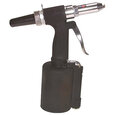Manual Rivet Tool
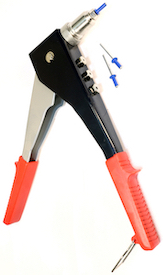
Figure 1: A manual rivet gun and pop rivets.
Riveting is the process of fixing two materials together using rivets. Manual rivet tools make a small job easy to complete. These tools are readily available since they do not require a power source. A user squeezes the handle of a standard rivet gun to operate the tool. This article further examines riveting, the types of manual rivet guns, how they work, and the pros and cons of these tools.
Table of contents
- What is riveting?
- What is a manual rivet tool?
- Operating principle
- Manual vs automatic rivet tools
- FAQs
View our online selection of pneumatic rivet guns!
What is riveting?
Riveting is the process of strongly and permanently fastening two pieces of material together using rivets. While there are many types of rivets, a basic rivet is a small steel shaft with a flanged end, as seen in Figure 2. The rivet goes into a pre-drilled hole in the material and deforms on one end. Deformation causes the rivet's end to widen, stopping the rivet from coming out of the hole.
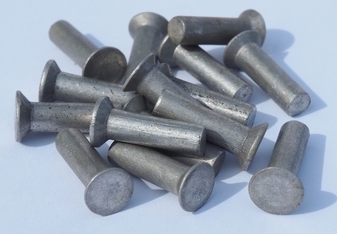
Figure 2: Basic rivets: a steel shaft with one flanged end.
What is a manual rivet tool?
A manual rivet tool is a handheld tool that installs a rivet using manpower rather than compressed air or electricity. It is an ideal tool for small riveting jobs because it is ready to use without setup. However, choose a pneumatic or electric riveting tool for larger riveting jobs. Prolonged use of a manual rivet tool causes hand pain.
There are a few types of manual pop rivet tools: standard rivet gun, heavy-duty lever riveter, lazy tong riveter, and long nose riveter. These different riveters have different operations.
- Standard rivet gun: Standard rivet guns (Figure 3 right) are the most common riveting tools due to their availability and ease of use. These tools typically have a nose piece that deforms blind rivets by pulling a mandrel to deform the rivet body. A user holds the front handle in one hand and pushes the back handle towards the front handle. This action causes the jaw assemblage behind the nose piece to pull on the mandrel until it falls off.
- Heavy-duty lever riveter: A heavy-duty lever riveter (Figure 3 left middle) is a long riveting tool with a nose piece, jaw assemblage, and two handles. The handles squeeze together to operate the tool. The handles provide extra leverage, allowing the installation of larger rivets.
- Lazy tong riveter: Lazy tong riveters (Figure 3 left) have a latticed framework. Pushing and pulling the handle towards and away from the nose piece works the tool.
- Long nose riveter: Long nose riveters (Figure 3 right middle) operate similarly to standard rivet guns, but have a longer nose piece for difficult to reach installation points.
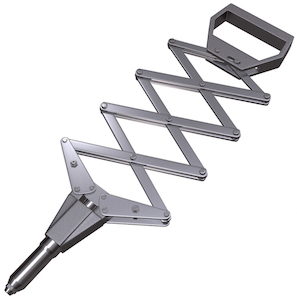
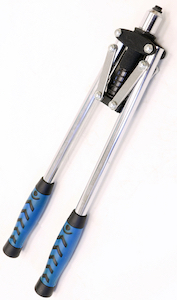
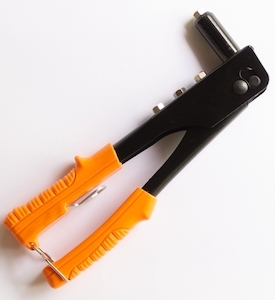
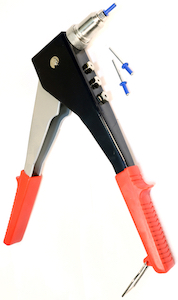
Figure 3: A lazy tong riveter (left), lever rivet gun (left middle), long nose riveter (right middle), and a standard rivet gun (right)
Rivet types
There are many types of rivets made of varying materials (e.g., plastic, aluminum, and steel). Different rivets have different applications. For example, a pop rivet is typical in DIY projects because it is strong enough for most small projects. However, solid rivets are more suitable when safety and reliability are crucial. Read our rivet-type article to learn more about the various types and uses of rivets.
Operating principle
Although the pop rivet guns in this article have different forms, their functions are very similar. Each tool has a nose piece and a jaw assemblage behind the nose piece. A jaw assemblage is a group of parts that work together to grip the rivet's mandrel and pull it backward. Each gun must operate multiple times to completely break off the mandrel, which means the rivet is fully deformed.
The following steps describe how to operate a manual rivet gun:
- Pre-drill holes through the materials that the rivets will fasten together.
- Ensure that the alignment of the separate materials is the same as it will be once the materials are fastened together.
- Insert the pop rivet’s mandrel into the manual rivet gun’s nose piece.
- Pass the body of the rivet through the pre-drilled holes.
- Squeeze the manual rivet gun’s lever.
- This causes the jaw assemblage to grip the mandrel and pull it away from the rivet’s body.
- As the mandrel is pulled away from the rivet’s body, the body deforms into a wider size.
- Squeeze the manual rivet gun’s handle as many times as necessary until the mandrel breaks off of the rivet’s body.
- When the mandrel breaks off, the rivet’s body is completely deformed and cannot come out of the pre-drilled holes.
Read our rivet tool maintenance article for more details on how to maintain a rivet gun.
Manual vs automatic rivet tools
As mentioned above, there are pneumatic and electric rivet tools. The following discusses the pros and cons of manual and automatic riveting tools.
Manual riveter
Pros
- Manual riveters are less expensive.
- Manual riveting tools are best for small-scale projects such as DIY or minor repairs.
- A manual riveting tool gives more control for precision work.
- Electricity and compressed air are not necessary to operate the manual rivet tool.
Cons
- Not suitable for large riveting jobs. Operating manual riveting tools for an extended period causes muscle fatigue.
- Larger, stronger rivets are harder to deform with a manual device.
- Longer operation times can result in misalignment of the riveted surfaces.
Automatic riveting tools
Pros
- Suitable for large jobs without risking muscle fatigue.
- These tools operate much faster than manual rivet tools.
- Electric and pneumatic riveting tools can be more precise if the user is very skilled.
Cons
- Significantly more expensive than manual riveters.
- A power source is necessary, whether a compressed air tank or electricity.
- Proper lubrication is crucial.
- If an inexperienced user operates an automatic riveting tool, the fast operation can lead to costly mistakes.
FAQs
Can you tighten a rivet?
No. Rivets are as tight as they will ever be upon installation. Over time, rivets can loosen or turn and even corrode.
How do I remove rivets?
The rivet shaft can be drilled out, or the shop end can be cut off, depending on the rivet, to allow the rivet shaft to be pulled through the surfaces it is joining.
Why are pop rivets used?
Pop rivets are necessary when one side of the fastened materials is not visible or accessible. The pop rivet gun pulls on the mandrel to deform the body of the rivet.
Are there different sizes of rivets?
Yes. Various rivet lengths, diameters, and even materials are available.




